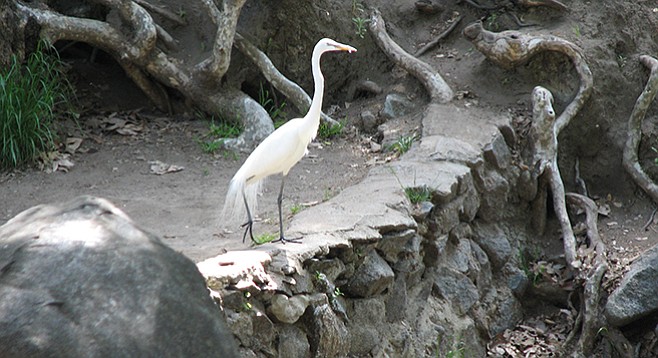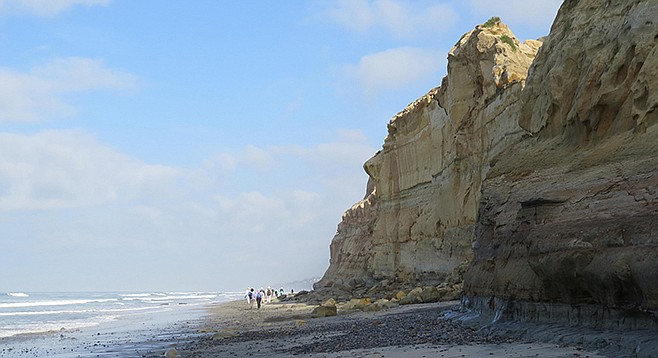 Facebook
Facebook
 X
X
 Instagram
Instagram
 TikTok
TikTok
 Youtube
Youtube

Birdwatchers need not despair now that the winter migrants are gone. Plenty of shore birds can be found on summer evenings in the natural coastal wetland areas of San Diego County. From south to north the publicly accessible coastal wetlands include the Tijuana River Estuary, south San Diego Bay (just north of Imperial Beach and along the bay shore at Chula Vista), the San Diego River channel (inland from Sea World), Los Peñasquitos Lagoon (adjacent to Torrey Pines State Reserve), the San Dieguito River estuary, San Elijo Lagoon, Batiquitos Lagoon, Agua Hedionda Lagoon, and Buena Vista Lagoon. In and around these areas look for California gulls, American avocets, brown pelicans, snowy egrets, killdeer, and redwing blackbirds.

Grunion may be active again early next week (Sunday and Monday nights, August 8 and 9), roughly during the hours of 9:45 p.m. and midnight, following the nocturnal high tide. The small, silvery grunion tend to spawn on wide, gently sloping beaches such as Silver Strand, Mission Beach, Pacific Beach, La Jolla Shores, and Del Mar. California law allows the taking of grunion in summer (except in those areas classified as ecological preserves) by those possessing a state fishing license. The grunion must be caught by the hands only, and should be eaten (not wasted).
Sunset challenge. I’ve said Regulus and Mars are disappearing for the season down to Venus’s lower left. Well, if you’d like a challenge, Regulus and Mars this evening are in conjunction, 0.6° apart. Get Venus in your lowest-power, widest-field eyepiece as soon after sunset as you can. Then shift to watch 8° to Venus’s lower right to see whether you can pick up Regulus and fainter Mars before they get too low and set in the fading twilight.
As summer progresses, Arcturus moves down the western side of the evening sky. Arcturus forms the bottom point of the Kite of Bootes. The Kite, rather narrow, extends upper right from Arcturus by 23°, about two fists at arm’s length. The lower right side of the kite is dented inward, as if some celestial intruder once banged into it.
The above comes from the Outdoors listings in the Reader compiled by Jerry Schad, author of Afoot & Afield in San Diego County. Schad died in 2011. Planet information from SkyandTelescope.org.


Birdwatchers need not despair now that the winter migrants are gone. Plenty of shore birds can be found on summer evenings in the natural coastal wetland areas of San Diego County. From south to north the publicly accessible coastal wetlands include the Tijuana River Estuary, south San Diego Bay (just north of Imperial Beach and along the bay shore at Chula Vista), the San Diego River channel (inland from Sea World), Los Peñasquitos Lagoon (adjacent to Torrey Pines State Reserve), the San Dieguito River estuary, San Elijo Lagoon, Batiquitos Lagoon, Agua Hedionda Lagoon, and Buena Vista Lagoon. In and around these areas look for California gulls, American avocets, brown pelicans, snowy egrets, killdeer, and redwing blackbirds.

Grunion may be active again early next week (Sunday and Monday nights, August 8 and 9), roughly during the hours of 9:45 p.m. and midnight, following the nocturnal high tide. The small, silvery grunion tend to spawn on wide, gently sloping beaches such as Silver Strand, Mission Beach, Pacific Beach, La Jolla Shores, and Del Mar. California law allows the taking of grunion in summer (except in those areas classified as ecological preserves) by those possessing a state fishing license. The grunion must be caught by the hands only, and should be eaten (not wasted).
Sunset challenge. I’ve said Regulus and Mars are disappearing for the season down to Venus’s lower left. Well, if you’d like a challenge, Regulus and Mars this evening are in conjunction, 0.6° apart. Get Venus in your lowest-power, widest-field eyepiece as soon after sunset as you can. Then shift to watch 8° to Venus’s lower right to see whether you can pick up Regulus and fainter Mars before they get too low and set in the fading twilight.
As summer progresses, Arcturus moves down the western side of the evening sky. Arcturus forms the bottom point of the Kite of Bootes. The Kite, rather narrow, extends upper right from Arcturus by 23°, about two fists at arm’s length. The lower right side of the kite is dented inward, as if some celestial intruder once banged into it.
The above comes from the Outdoors listings in the Reader compiled by Jerry Schad, author of Afoot & Afield in San Diego County. Schad died in 2011. Planet information from SkyandTelescope.org.
Comments